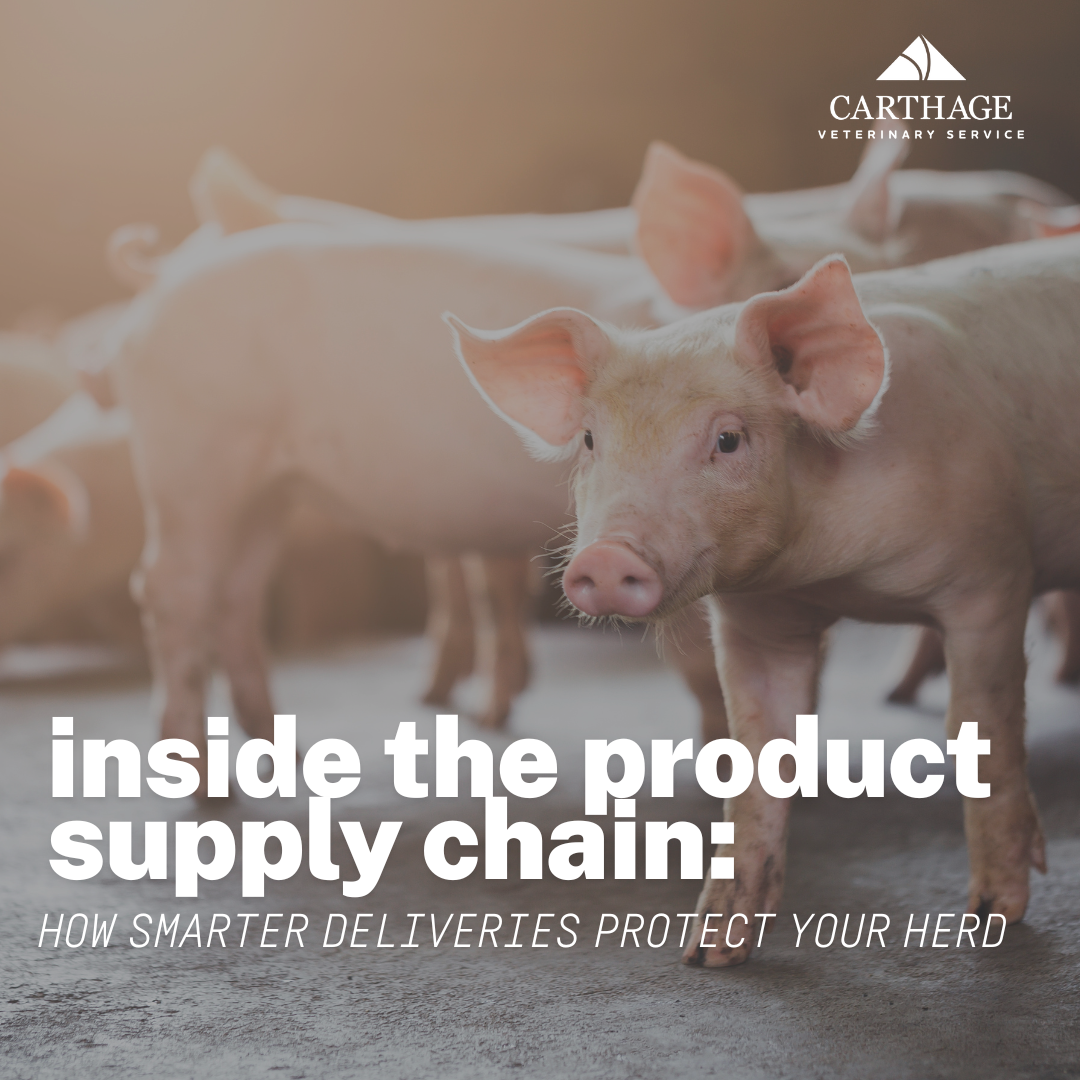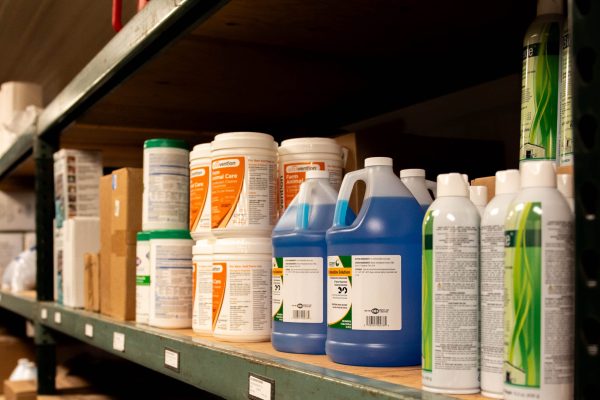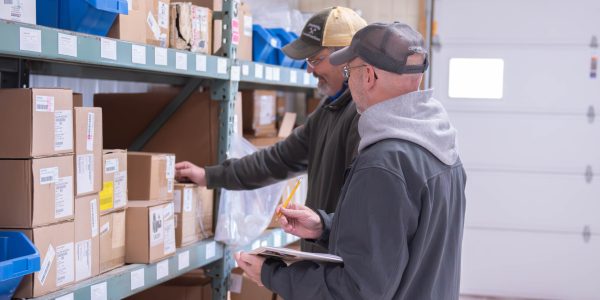
Streamlining deliveries and managing biosecurity risks that comes with supply deliveries can be narrowed down to a few key habits.
From farrowing and vaccine schedules to transportation and disease monitoring, producers put great planning into caring for their pigs. Most are also very conscious of the need for strict biosecurity protocols, especially in the past decade when practices have been more scrutinized and proven critical to overall farm health.
But here’s the question: are you tying those two priorities together when it comes to supply orders?
The easiest place for me to begin with this topic is Carthage Veterinary Service (CVS) Supply Division’s own storage, ordering and delivery practices. Our goal is to make ordering and delivery as biosecure and simple as possible, and we constantly review our processes for improvement and adjustments to stay on top of it. I’ll share a few practices here, not as a checklist you must follow, but as ideas to ask about with your own supplier or to adapt to your specific farm needs.
Our online and mobile ordering tools are designed to take some mental load off the producers to do list. If you typically use the same volume of a certain medication or supply each month, our platform can help you streamline that process to take the guesswork out of how much you need and by when. It allows each individual farm to set minimum and maximum levels of items they want to control and encourages them to place one order per month for all those items. Of course, you can adjust quantities and add extras for specific needs out of the norm. Producers who use approximately the same number of certain medications and other supplies each month see this as one less worry in their day-to-day business.


Behind the scenes, we work to stay efficient and prepared. About 95% of what we ship comes from one trusted supplier, but we also source specialized items like equipment, parts or unique swine supplies from others. We also work to keep an eye on supply chain trends, stock ahead if we see a shortage coming, and let producers know if allocations might be limited. Additionally, we keep flex warehouse space to handle seasonal spikes, like when certain diseases historically flare up. Our goal with all of these is to make the ordering process as seamless as possible for the end user and only alert them and make changes as necessary.
Last fall, we worked with the Carthage System to institute a seven-day downtime on all standard supply orders going into the farm. The producer places their order a week in advance so our team has time to order, consolidate and plan delivery. The products are then delivered together to a biosecure chamber at the farm, where it stays enclosed for seven days before being moved to the farm’s regular storage space. It adds another buffer to reduce the risk of introducing anything unwanted.
And just like you set rules for who can enter your barns, we do the same in our warehouse. Only designated staff are allowed in, with strict biosecurity in place, because protecting the cleanliness of your supplies starts well before delivery.
When it’s time for your product to ship, we use a primary dedicated distribution partner that dedicates part of its fleet solely for CVS deliveries. Our team creates a schedule for their drivers and trucks by region and farm health status so high-health farms are delivered to first, while farms dealing with something like PRRS are moved further down the route. This schedule can and does change in real time if any one of the farms on the route experiences a health outbreak.
The trucks are washed at the end of every route at our facilities and tires are sprayed with disinfectant in between each stop. Drivers are trained to use booties and other appropriate measures when they get out of their truck on a delivery. Deliveries are typically left on a pallet at the gate that the producer can move with their own tractor after the truck leaves.
These biosecure deliveries are generally reserved for sow farms. Deliveries to finishing operations are typically made by a regional carrier or national carrier, since they usually don’t order as many supplies as often.
If you work with a supplier that does not offer this level of biosecurity, there are still steps you can take to make deliveries safer on your farm.
For sow farms in particular, consider reducing the number of deliveries you receive. Each and every box is a potential risk, so placing one large monthly order instead of several smaller ones can help limit exposure. This can seem overwhelming to start but can easily be done using your past supply purchasing data to forecast monthly needs and add a small cushion to be safe. Even if you aren’t sure you can get it down to a monthly order, work on a bi-weekly delivery to start and remember that any decrease in shipments will trim disease introduction risks.
You can also set up a secure delivery location at your gate to stop drivers from coming on your farm and up to the door. I can’t tell you the number of stories I’ve heard of a delivery driver coming inside a farm or opening doors. While most of the time you might have a regular driver that knows your protocol, substitute drivers might not get the information. Any signage you can create or delivery drop point you can identify will be helpful in those situations. Most delivery services also send alerts or notifications when the delivery is complete, so you can then move it to the quarantine supply room.
If you don’t already have a quarantine supply room, set one up. It doesn’t need to be big or require new construction either. A closet or a blocked-off corner of your existing supply space works just fine. What matters is that everyone knows quarantined items are off-limits until the downtime period is over. If you can keep the area locked and limit access to only a few people who clear items when the time is up, it’s even better.
One of the most valuable steps you can take with any supplier or distributor is to keep open consistent communication. That includes flagging delivery issues, pointing out product design issues, or letting them know if you expect higher usage due to herd health changes. The reality is your feedback may be the first time your supplier has heard a problem is happening. By asking the question or raising the concern, you give them the opportunity to talk with their vendors, manufacturers, or shipping partners before the situation snowballs. Proactive communication doesn’t just help you, it helps strengthen the entire supply chain and ensures your farm has what it needs when it needs it.
At the end of the day, streamlining deliveries and managing biosecurity risks that comes with supply deliveries can be narrowed down to a few key habits: consolidating orders to cut down risk, setting up a simple quarantine space, making use of secure drop points, and keeping the lines of communication open with your suppliers. Each step may feel small on its own, but together they build stronger biosecurity, smoother supply flow, and less stress on your daily operations. Protecting pig health is always the top priority and by tightening up how supplies are ordered, stored and delivered, you’re adding another layer of defense that benefits your farm, your pigs, and ultimately, the entire industry.